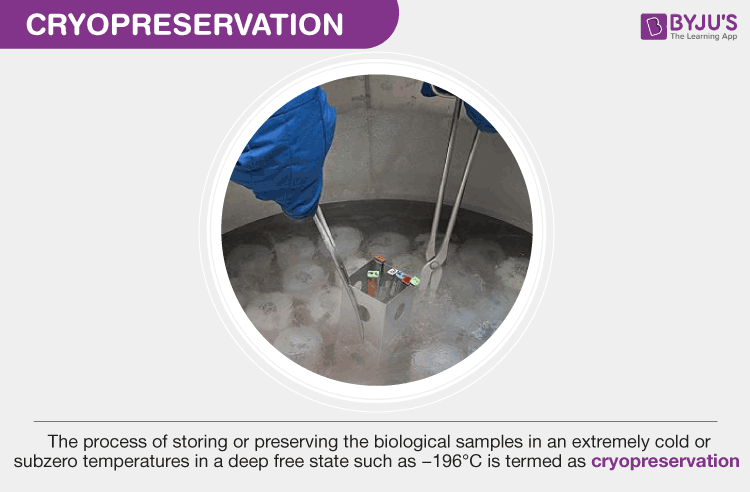“Cryopreservation is the use of very low temperatures to preserve the cells and tissues that are structurally intact.”
Table of Contents
- Explanation
- Process
- Steps
- Embryo Cryopreservation
- Oocyte Cryopreservation
- Sperm Cryopreservation
- Benefits
- Applications
What is Cryopreservation?
Cryopreservation is the method of keeping the live cells, tissues and other biological samples in a deep freeze at subzero temperatures for the storage or preservation. The sample is commonly kept at −196°C.
At such low temperatures, all the biological activities of the cells stop and the cell dies. Cryopreservation helps the cells to survive freezing and thawing.
The ice formation inside the cells can break the cell membrane. This can be prevented by regulating the freezing rate and carefully choosing the freezing medium.

Cryopreservation Process
In this process, biological materials including cells, oocytes, spermatozoa, tissues, ovarian tissues, pre-implantation embryos, organs, etc. are kept in extremely cold temperatures without affecting the cell’s viability.
Dry Ice and liquid nitrogen are generally used in this method.
Cryopreservation Steps
The complete procedure steps involved in preserving the obtained biological samples are as follows:
-
Harvesting or Selection of material– Few important criteria should be followed while selecting the biological materials such as – volume, density, pH, morphology, and without any damage.
-
Addition of cryo-protectant – Cryoprotective agents such as glycerol, FBS, salts, sugars, glycols are added to the samples as it reduces the freezing point of the medium and also allow slower cooling rate, which reduces the risk of crystallization.
-
Freezing – Different methods of freezing are applied in this method of cryopreservation to protect cells from damage and cell death by their exposure to the warm solutions of cryoprotective agents.
-
Storage in liquid nitrogen– The cryopreserved samples are stored in extreme cold or -80°C in a freezer for at least 5 to 24 hours before transferring it to the storage vessels.
-
Thawing- The process of warming the biological samples in order to control the rate of cooling and prevent the cell damage caused by the crystallization.
Further Reading: Cell Theory
Cryopreservation of Embryos
During the infertility treatment, hormones are used to stimulate the development of eggs. The eggs are then taken out and fertilized in the lab. More embryos can be created and transplanted to the woman’s uterus. These embryos can be cryopreserved and can be used at some later date. By this, the female can get an additional transfer of embryo in future, without spending on another IVF cycle.
Oocyte Cryopreservation
In the vitrification method, the eggs freeze rapidly so that there is less time available for the formation of ice crystals. New cryoprotectants are used with a high concentration of products with anti-freeze property.
The oocyte is first placed in a bath containing a low concentration of anti-freeze like cryoprotectant. Some sucrose is added to help draw some water out of the egg. The egg is then shifted to high concentration anti-freeze cryoprotectant for very few seconds and then immediately transferred to liquid nitrogen. When the egg is thawed and used for the transplantation into the woman.
Cryopreservation of Sperm
The semen sample is mixed with a solution, which provides protection during freezing and thawing. Followed by transfer to plastic vials, which are then kept in liquid nitrogen for freezing.
This process ensures the chances of conception in future. The sperm can also be deposited, froze and stored in cryobanks for less than a year. These sperms can later be used for certain infertility treatment procedures.
Benefits of Cryopreservation
There are many benefits of cryopreservation technique. These include:
-
Fertility treatments.
-
Minimal space and labour required.
-
Safety from genetic contamination.
-
Safeguards genetic integrity of valuable stains.
-
Safeguards the germplasm of endangered species.
-
Biological samples can be preserved for a longer period of time.
-
Protects the samples from disease and microbial contamination.
-
Prevents genetic drift by cryopreservation of gametes, embryos, etc.
Applications of Cryopreservation
Cryopreservation is a long-term storage technique, which is mainly used for preserving and maintaining viability of the biological samples for a longer duration.
This method of preservation is widely used in different sectors including cryosurgery, molecular biology, ecology, food science, plant physiology, and in many medical applications. Other applications of cryopreservation process are:
-
Seed Bank.
-
Gene Bank.
-
Blood transfusion.
-
In vitro fertilization.
-
Organ transplantation.
-
Artificial insemination.
-
Storage of rare germplasm.
-
Freezing of cell cultures.
-
Conservation of endangered plant species.
-
Biodiversity conservation.
This was an introduction to Cryopreservation, its Applications, process, and advantages. For more information, stay tuned with BYJU’S.
Articles of Interest
- Exocrine Glands
- Germ Theory Of Disease
- VNTR (Variable Number Of Tandem Repeats)
- Foster’s Rule
- Allee Effect
- Bioluminescence
- Placebo Effect
Frequently Asked Questions
Which chemical is used in cryopreservation techniques?
Liquid nitrogen is used in cryopreservation technique.
How are the cells placed in liquid nitrogen revived?
The cryovials containing frozen cells are revived by placing them in a water bath of 37°C. The vials are thawed until negligible ice is left in the vial. The vial is then transferred to the laminar flow.

Its a really nice website. Thanks for giving full information about Cryopreservation.
Reference?